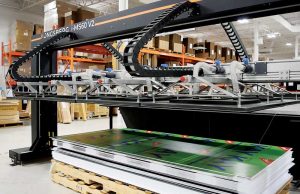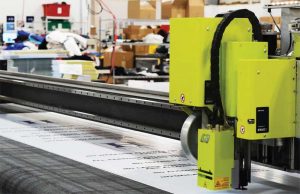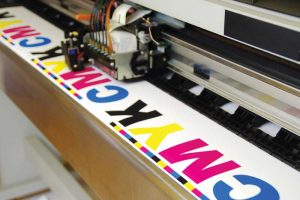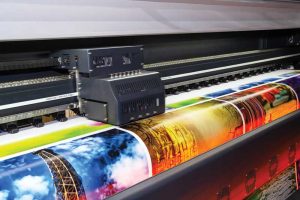Exploring wide-format printing trends
by carly_mchugh | 10 February 2023 10:08 am
 [1]
[1]Wide-format printing is becoming more accessible and more affordable, thanks to new developments in processes as well as equipment. Photos courtesy SinaLite
By Brian Meshkati
Today’s technology allows sign shops and print companies to produce larger items, while still maintaining high-quality standards and efficiency. These developments contribute to the success of the wide-format printing market, which is forecast to reach a value of US$11.4 billion (C$15.4 billion) in 2026—up from US$8.8 billion (C$11 billion) in 2021.1 They also help these businesses offer more products to their customers, which, in turn, ensures steady revenue.
As with any other practice, wide-format printing has progressed as technology and consumer behaviour changes, giving rise to new trends. The category continues to evolve, so new trends are expected to arise in the coming months and years.
Here is a look at some of the current and emerging trends print service providers (PSPs) can expect to see in 2023 and beyond.
Developments in wide-format printing
Wide-format printing is becoming more accessible and more affordable, thanks to new developments in processes and equipment. Some of these developments include ultraviolet (UV)-curable inks, the ability to print on rigid media, and contour cutting technology.
UV-curable inks
UV-curable inks make it easier for PSPs to print on a wider range of substrates. This includes materials such as glass, plastics, and metals, which do not absorb other types of ink. Another benefit to using UV-curable inks is lower costs, which can be passed on to end customers. These inks also allow for faster completion times and are better for the environment compared to many other types of inks.
Printing on rigid media
Wide-format printers can now print directly onto a variety of hard surfaces, eliminating previously necessary, time-consuming steps. For example, the process used to include printing on a softer surface first, which would then be transferred to the harder surface. Eliminating these steps helps make printing on these types of media faster and more cost-effective.
Contour cutting
The latest contour cutting technology allows printers to cut a design to precise dimensions. With help from digital technology, designs can be cut easily, quickly, and accurately, to ensure the product is made to precise specifications. This technology also helps to make the process faster and helps reduce overall costs.
 [2]
[2]Today’s printing technology has allowed service providers to produce larger items, while still maintaining high-quality standards and efficiency.
Producing small print runs
In the past, one of the biggest problems with printing was the cost and time of setting up equipment—including templates for specific print jobs. This issue meant customers would have to make large orders for the job to be cost-effective. Of course, this was no good to companies that only received small orders, meaning many would have to look for alternatives.
In 2023, more companies will likely make small wide-format orders, including single-item runs. Technological developments have now made small runs economically viable for PSPs and their customers. Consumers can now make customized, bespoke orders for high-quality, wide-format products without breaking the bank. Small runs also make it more affordable to experiment, helping businesses and their clients find formulas to boost sales and revenue.
Another benefit of having small run capability is it lets print companies and sign shops offer a wider range of services to their clients. In some cases, offering small runs will even help a company attract customers away from their competition. Additionally, when a customer uses a company for one service, they are more likely to use its other services. A single, small-run order can sometimes develop into a long-term partnership, which is fruitful for both parties involved.
 [3]
[3]Ultraviolet (UV)-curable inks make it easier to print on a wider range of substrates, allow for faster completion times, and are better for the environment compared to many other types of inks. Photo © Awargula | Dreamstime.com
Interior decor
Another trend likely to flourish in 2023 is interior decor. It is emerging because of the quality wide-format printing can now offer, producing creations clients are proud to display in their homes or offices.
Wide-format printing opens up a range of new opportunities and helps property owners create unique designs. For example, it can be used to make bespoke wallpaper, giving homeowners a chance to have decor they are not able to find anywhere else.
PSPs can even print onto fabrics, opening up new options such as custom-printed upholstery and curtains. With so much flexibility in terms of materials, wide-format printing opens up a world of options for home decorating.
Improved sustainability
“Sustainability” has become a buzzword for nearly every trade worldwide, and the printing industry is no exception. It is important for businesses to take note, especially considering approximately 75 per cent of millennials are mindful of sustainability when buying products.2 As such, if a print company does not employ sustainable practices, there is a chance it will lose customers to a competitor who does.
The good news is wide-format printing technology is more sustainable than ever. This is partly because of the newer inks available, which are increasingly more eco-friendly than older alternatives. Other reasons for improved sustainability include less waste and energy use, which reduce demands on the power grid and on natural resources.
Faster completion times
Customers often need their orders completed as quickly as possible, but traditional printing methods tend to be time-consuming and have long lead times. Wide-format printing can now be completed faster than earlier methods. Not only does this mean more satisfied customers, but it also means print companies and sign shops can take on more work. Technological developments have helped speed up the work in two important avenues: design and printing.
Design
With help from a wide range of software and hardware, it is now easier than ever to create unique print designs. Further, today’s PSPs do not have to spend time and money on creating new templates—many of which they will only use once. Instead, the job details can be uploaded digitally, which takes just a few moments.
Printing
The print process itself is also much faster, thanks to advanced machinery that automates many tasks. Not only does automation allow PSPs to complete jobs quicker, but it also improves accuracy and reduces the need for costly wages.
It has become increasingly important for printers and signmakers to offer fast completion times to keep their businesses competitive. After all, clients now have higher expectations, and businesses that do not meet them are likely to lose out to their quicker competitors.
If sign shops and print companies are having difficulties meeting client deadlines, they also have the option to turn to wholesale trade printers—who have implemented next-business-day turnaround for popular items like Coroplast yard signs.
 [4]
[4]Wide-format printing will create many more exciting opportunities to explore new markets and offer more to customers. Photo © Dmytro Tolmachov | Dreamstime.com
Working with new materials
With the latest printing equipment, PSPs can now print on a wider range of media with relative ease. This has led to an increase in the amount of signage made with fabric, vinyl, canvas, and foam. Depending on which materials are used, they can be light, flexible, and durable.
Access to a larger variety of materials tends to promote more creativity. This added flexibility helps ensure companies can use the right medium to get their message across, boosting revenue and enhancing their brand’s image. Large-format printing can even be used with illuminated displays and other media, which can make signage and exhibits even more impactful.
More packaging options
Printing in large format also includes producing custom packaging. Recent developments have made personalized packaging materials easier and more affordable to print. Not only can wide-format printing help reduce costs, but it can also do so without sacrificing quality. Further, PSPs can print on a wide range of materials, such as corrugated card and shrink wrap.
However, the benefits of using wide-format printing for packaging do not stop there. Since improvements in technology have allowed printers to produce small runs more affordably, companies can also offer more customization at lower price points. Customized packaging is a potentially powerful marketing tool, helping print companies offer a product which is in high demand from small businesses.
For example, the author’s company has started to offer affordable short-run mailer boxes. Their clients—which consist of sign shops and print resellers—are able to order these boxes without a minimum order quantity, in standard or custom sizes to meet their customers’ needs.
Conclusion
These are just some of the wide-format printing trends sign shops and print companies are likely to see in 2023 and beyond. As more emerge, it is important for PSPs to stay informed, so they can take full advantage and stay ahead of competitors.
Up-and-coming trends will also be driven largely by developments in technology, as well as changes in customer behaviour and preferences. The industry is always looking to improve on the services it can offer, to add flexibility, shorten lead times, and improve quality—even at reduced costs. Technological developments in wide-format printing will also help limit damage to the environment, which will help make products more appealing to consumers.
There will always be new challenges for sign shops and print companies, especially during unstable economic times. However, wide-format printing will create many more exciting opportunities to explore new markets and offer more to customers.
Notes
1 For more information, visit https://www.marketsandmarkets.com/Market-Reports/large-format-inkjet-printers-lfp-market-523.html.
2 For more information, visit https://www.businessnewsdaily.com/15087-consumers-want-sustainable-products.html.
Brian Meshkati is the vice-president of SinaLite, a trade printer serving North America. He leads marketing, product development, and customer engagement to equip the company’s continued growth. Meshkati enjoys helping printing and packaging companies grow effectively in a competitive market.
- [Image]: https://www.signmedia.ca/wp-content/uploads/2023/02/WF_.jpg
- [Image]: https://www.signmedia.ca/wp-content/uploads/2023/02/WF_Image-3.jpg
- [Image]: https://www.signmedia.ca/wp-content/uploads/2023/02/dreamstime_xl_107592694.jpg
- [Image]: https://www.signmedia.ca/wp-content/uploads/2023/02/dreamstime_l_127037103.jpg
Source URL: https://www.signmedia.ca/exploring-wide-format-printing-trends/